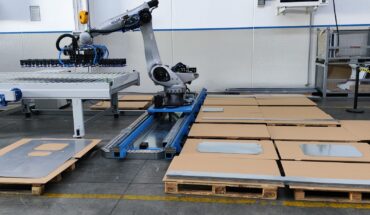Data is no longer merely a byproduct of processes, it’s the central asset that drives innovation, efficiency and competitive advantage.

In today’s business world of connected manufacturing, supply chain and operation, digital transformation is an essential element in a successful manufacturing business. The goal is continuous product lifecycle and product data management covering a digital thread from early design and engineering to supply chain management and maintenance.
The push for digital transformation in product lifecycle management (PLM) comes from our everyday experiences, where nearly every aspect of our personal and professional lives is mediated through digital tools.
For businesses, this shift toward digitalization raises a crucial question: How can all these tools, applications and processes coordinate seamlessly to deliver value and innovation? Just a few years ago this was limited to focusing on specific tasks or processes, but now the demand is to have up-to-date information on every tool or system you use.
We live in a hyper-connected era where systems must communicate and adapt in real time. Businesses face the challenge of managing increasingly complex ecosystems of applications, each with their own data and processes. This complexity demands a shift from traditional, siloed thinking to a more integrated, data-driven approach.
Navigating this transformation requires rethinking how data and applications interact, enabling businesses to achieve greater flexibility, efficiency and innovation.
Enterprise Applications as Process Enablers
Historically, business systems and enterprise applications were built to support specific functions and processes within a business. These tools were designed to operate within narrowly defined parameters, focusing on individual data sets, including:
- CAD Applications focused on creating and managing design data, enabling engineers to develop and iterate on product designs.
- MRP Systems (Material Requirements Planning) supported resource allocation and production planning to ensure efficient manufacturing processes.
- CRM Tools (Customer Relationship Management) managed customer interactions, sales pipelines, and support workflows.
While effective for their intended purposes, these applications were largely self-contained with minimal connectivity to other systems. Think of a PLM solution, supply chain, document management or production process. Although companies demanded interoperability, most of these projects were about how to “sync” data from design and engineering to material planning/ ERP rather than setting up a collaborative environment.
Data was treated as a byproduct of the process rather than a core asset. Over time, this siloed approach led to fragmented data landscapes, making it difficult to achieve the integration and real-time insights needed for modern business operations.
The result? Legacy systems often struggle to adapt to the demands of a digital-first world, where agility, collaboration and innovation are paramount. As businesses scale and evolve, the limitations of process-centric architectures become increasingly apparent.
The Shift to Data-First Thinking
Digital transformation fundamentally changes the relationship between processes and data. In the traditional model, processes dictated how data was structured, stored and accessed. Digital transformation flips this paradigm, prioritizing data as the foundation of modern business operations. Companies shift their attention on how to trust data, because data lives longer than applications and business tools. The design history goes on for years, but a company can switch CAD and PDM applications. Data records are more important, and here are some key reasons:
- Real-Time Insights: Data provides the foundation for real-time analytics, enabling businesses to make informed decisions quickly and respond to changing conditions.
- Flexibility and Adaptability: Processes are inherently static and limited to predefined scenarios, while data enables dynamic, context-aware responses.
- Collaboration Across Ecosystems: By connecting data through a digital thread, businesses can ensure seamless collaboration across design, manufacturing, and operations.
- Long-Term Value: Unlike processes, which can be reengineered relatively quickly, data accumulates value over time. A robust data foundation supports innovation, automation, and strategic decision-making.
In this new paradigm, data is not merely a byproduct of processes, it’s the central asset that drives innovation, efficiency, and competitive advantage. Businesses that prioritize data management are better equipped to navigate the complexities of digital transformation and achieve sustainable success.
Rethinking the Status Quo
For decades, enterprise applications like PLM (Product Lifecycle Management) systems have been designed to organize engineering processes within organizations. These systems emphasized creating a ‘single source of truth,’ focusing on managing product data records (e.g., design files, engineering documents) and enforcing processes such as data approval, versioning and updates.
PLM was an effective approach when the demand was to store data and gatekeep access. Today, this misalignment of the traditional PLM approach is becoming obvious. PLM tools should become a source of data shared with everyone.
The foundation of the switch is how PLM software adapts, becoming an “agent” that performs specific tasks on the data, such as engineering change order approval. This shift from a process-centric to a data-centric approach requires rethinking foundational concepts such as the single source of truth and adopting new strategies that prioritize collaboration, flexibility and adaptability.
A Single Source of TRUTH Change
In the context of digital transformation, the traditional single source of truth is evolving into a single source of change. This new approach emphasizes:
- Dynamic Data Organization: Data is no longer confined to rigid hierarchies or processes. Instead, it is modeled and organized to reflect real-world relationships and dependencies.
- Collaborative Workspaces: Data becomes a shared resource that enables cross-functional collaboration, regardless of where it originates or is maintained.
- Context-Aware Data Management: Systems must understand not only what the data is but also how it is connected, who can change it, and under what circumstances.
Instead of treating data as a secondary consideration, businesses must prioritize creating flexible, adaptable data models that reflect the complexity and interconnectivity of modern operations.
Practical Strategies for Disconnecting Data from Applications
Switching to a data-first approach can be challenging, especially for companies with old systems deeply tied to specific software. Some companies have data from a dozen ERP systems and several PLM applications including legacy databases. What can those companies do? Here are a few practical approaches:
Rethink Data Models
Traditional data models are often built around specific applications, which makes it hard to use data across different systems. Most traditional data systems use relational SQL databases with inflexible schemas. To solve this, companies should use modern flexible data models that don’t rely on fixed structures and can change as needed.
Graph databases are a great option because they are good at handling complex connections between data. It’s also important to organize data in a way that lets systems understand its meaning and context, making it easier to work with.
Decouple Data from Applications
Data shouldn’t depend on specific software—it should stand alone as a valuable resource. To achieve this, companies can combine data from various systems into one central place for easier access. Using tools like APIs and integration layers helps different applications share data seamlessly. Another option is data federation, which keeps data in its original systems but allows centralized access and visibility.
Knowledge Graph and AI models
This is a modern data modeling approach which is growing. A product knowledge graph organizes all product-related data—design, engineering, and manufacturing details—in one connected system. This ensures data is consistent and accurate across all areas. It also supports better decision-making with advanced analysis tools and makes it easier for different teams to work together by sharing the same information.
With a huge spike in GPT and LLM models, we can see how these models can consume data in a more holistic way disconnected from the applications where the data was originally created. They can also provide quick insights and help find the information you need from large data sets quickly and accurately, to support various chatbots and future analytics and AI agents.
Collaborative Data Management
In a data-first setup, teamwork is key. Companies should enable real-time data sharing so everyone has up-to-date information. Teams across different departments need tools to work together effectively, and clear processes for managing changes are crucial to ensure everyone stays on the same page and changes are tracked.
By following these strategies, businesses can move away from outdated, application-tied data systems and unlock new possibilities for efficiency, innovation, and growth.
Embracing the Future of Data-Driven Manufacturing
We are living through a period of profound transformation in manufacturing and PLM. The traditional model of application-defined data is giving way to a new paradigm of data-defined action. This shift represents a fundamental rethinking of how businesses approach data, applications, and processes.
By prioritizing data as the central asset of their operations, businesses can:
- Achieve greater flexibility and adaptability.
- Drive innovation and efficiency through real-time insights.
- Build resilient, future-ready systems that support long-term success.
The transition to a data-first approach is not without its challenges, but the rewards are immense. By embracing modern data management strategies and technologies, businesses can position themselves at the forefront of digital transformation, unlocking new opportunities for growth, innovation, and competitive advantage.





